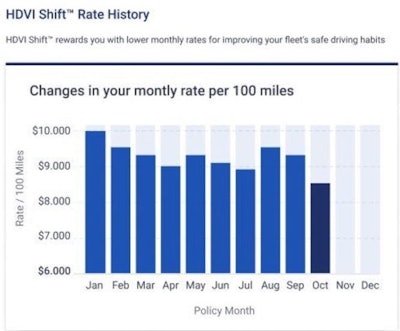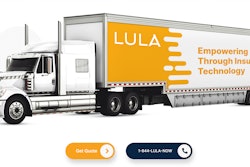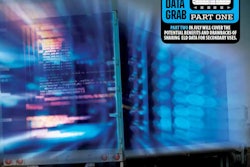This summer, the HDVI (High-Definition Vehicle Insurance) company, part of an "insuretech" category of firms venture capital has increasingly shown interest in, introduced its HDVI Shift product. It's a commercial auto insurance policy, then available in seven states and expected to be in 12-13 by the end of the year, aimed at small and mid-sized trucking fleets that delivers monthly savings to policyholders based in part on their safety performance.
 Read more about the HDVI company via Overdrive sister publication CCJ via this link. This image supplied by the company offers an example of up-and-down monthly rate movement in the variable-rate HDVI Shift program.
Read more about the HDVI company via Overdrive sister publication CCJ via this link. This image supplied by the company offers an example of up-and-down monthly rate movement in the variable-rate HDVI Shift program.
Huddleston Enterprises, a 22-truck dry van carrier based in Memphis, Tennessee, started an insurance policy on June 1 with HDVI, as reported originally in Overdrive sister publication CCJ. Just a few months into it, the company had already saved 4.8% on the original premium after two successive months of getting discounts, said Brian Crawford, safety director.
Crawford credited daily interaction with driver behaviors and driver incentive programs for helping the fleet achieve the savings. The HDVI safety dashboard gives fleets details on risk factors such as harsh events like hard braking, distracted driving, speeding, and more, all captured via telematics devices.

The chance to save is no doubt an attractive carrot to the smallest fleets and one-truck independents, as premium cost increases continue to be the norm all around the commercial auto liability insurance landscape. Since Overdrive covered Progressive's moves to incentivize ELD data-sharing by carriers with the insurer, part of our "ELD Data Grab" two-part series in 2019, new players like HDVI are pushing the envelope further toward dynamic direct connections with their insured carriers.
Another "insuretech" player, the Cover Whale company, meanwhile, pitches its coverages directly to the smallest of fleets through its online system in addition to offering its platform to other insurance agencies.
"Our average number of trucks per account is 1.5," said Dan Abrahamsen, Cover Whale CEO. "There are many insurers who ignore this type of business – they think it’s not worth their time and they can’t make any money on it," given manpower needed throughout the policy year to effectively serve a multiplicity of small customers. Cover Whale focused on buttoning up its online system to allow individual carriers a great deal of self-service options, "investing in the platforms to make it easier to make policy changes," among other things.
Like HDVI to an extent, telematics data and other on-board technology makes a connection between covered carriers and their insurer that's much more direct than is typical with traditional agencies. "There's a [video] camera and coaching component to what we do," Abrahamsen said. The company seeks to help carriers control losses and thus achieve better insurance rates by keeping tabs on telematics data, too -- most ELDs are supported in the program, he added.
"We believe the majority of drivers out there to be good drivers," Abrahamsen added. "There should be better pricing and other benefits that come along" with the tech elements in place to support the carrier and insurer. "Having these in place helps us as the insurer defend the driver," avoid massive losses and deliver better rates to carriers in the end.
A one-truck independent "doesn’t have the same kind of target on his back" as a driver for a big trucking company might when it comes to post-crash litigation, yet often enough "people go after the full million-dollar limit," common for any trucker's commercial auto-liability policies, he said. Abrahamsen offered the example of a minor injury crash. As few as 10 years ago, like as not, "the limit wouldn’t be awarded" in such a case. Yet the public profile of ever-larger jury awards makes it more likely today. "What we do with the coaching program in place and the camera -- a lot of times the camera will show the driver wasn’t fully at fault. That helps us. It also kind of shows a safety culture, that we have a driver here that cares about safety. All of it takes away some of the teeth from litigators looking for a big payout."
Cover Whale policies for physical damage and cargo insurance are available in most states, Abrahamsen said, though its commercial auto liability policies are available in just 15 states so far. The company also facilitates non-trucking liability for leased owners.
It's not varying insureds' rates during a policy year in the way HDVI is, though the company does continue to "think about that as an option," Abrahamsen said. For carriers tied in with a driver safety reporting system with the insurance company who have good scores, "rates should reflect how you're driving" with a "product option to allow them rate relief with improvement."
[Related: How much is your ELD data worth?]









